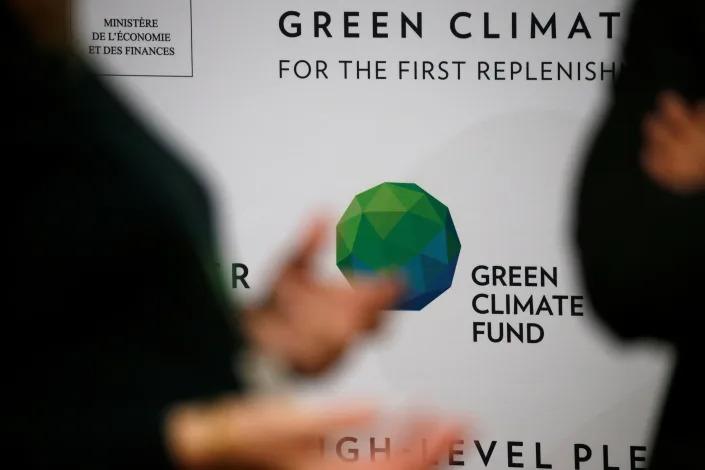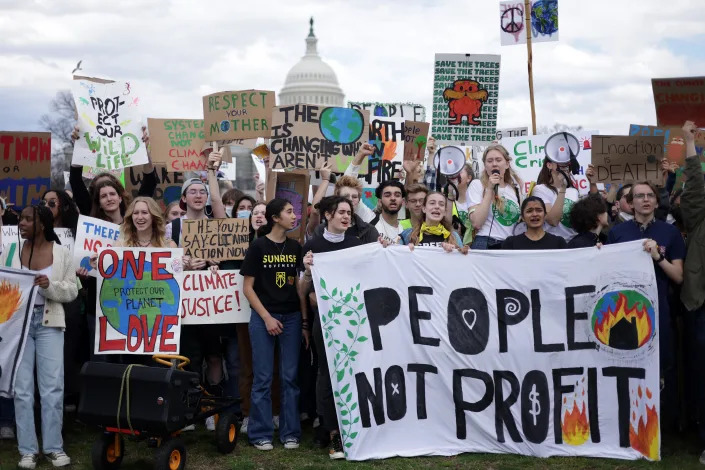After the Senate passed the $1.7 billion omnibus spending bill Thursday, climate change activists bemoaned a key promise of President Biden’s that won’t be met: $11.4 billion in climate aid per year to developing countries.
Ben Adler
·Senior Editor
Thu, December 22, 2022
President Biden at the White House on Thursday.
(Alex Wong/Getty Images)
The Senate passed the $1.7 billion omnibus spending bill Thursday, averting a government shutdown, but climate change activists are upset that a key promise of President Biden’s won’t be included in the package: $11.4 billion in climate aid per year to developing countries.
In a September 2021 speech to the United Nations General Assembly, Biden pledged to increase U.S. assistance to low-income nations for combating climate change through building their clean energy economies and adapting to the dangerous effects of climate change, such as sea level rise, to $11.4 billion. Biden later moved his request to Congress up to 2023 — the fiscal year currently under consideration — including $2 billion the U.S. already owes the Green Climate Fund, a U.N. initiative that distributes climate financing.
But, despite Biden’s fellow Democrats holding slim majorities in both houses of Congress, the spending package includes just $1.057 billion for international climate change aid. That is “only $900,000 more than the previous year’s already woefully short amount,” climate policy experts at the Natural Resources Defense Council (NRDC) lamented in a blog post on Wednesday.

A pledging conference of the Green Climate Fund in Paris, Oct. 25, 2019.

Yannick Glemarec, center, currently executive director of the Green Climate Fund, speaking at the Atlantic Council in 2018.

People wade past stranded trucks on a flooded street in
The Senate passed the $1.7 billion omnibus spending bill Thursday, averting a government shutdown, but climate change activists are upset that a key promise of President Biden’s won’t be included in the package: $11.4 billion in climate aid per year to developing countries.
In a September 2021 speech to the United Nations General Assembly, Biden pledged to increase U.S. assistance to low-income nations for combating climate change through building their clean energy economies and adapting to the dangerous effects of climate change, such as sea level rise, to $11.4 billion. Biden later moved his request to Congress up to 2023 — the fiscal year currently under consideration — including $2 billion the U.S. already owes the Green Climate Fund, a U.N. initiative that distributes climate financing.
But, despite Biden’s fellow Democrats holding slim majorities in both houses of Congress, the spending package includes just $1.057 billion for international climate change aid. That is “only $900,000 more than the previous year’s already woefully short amount,” climate policy experts at the Natural Resources Defense Council (NRDC) lamented in a blog post on Wednesday.
A pledging conference of the Green Climate Fund in Paris, Oct. 25, 2019.
Pascal Rossignol/Reuters
Congressional Democrats had sought $3.4 billion for global climate programs this year, but Republicans blocked what Republicans on the Senate Appropriations Committee called “radical environmental and climate policies.”
“Congress just bankrolled an $857 billion defense bill but failed to provide a single penny to meet our commitments to the Green Climate Fund — a step that would truly help us defend our country and our planet from chaos and instability,” Sen. Ed Markey, D-Mass., said on Twitter.
As Bloomberg News observed, “with Republicans taking control of the House in January, the fiscal 2023 budget was seen as the last best chance for Biden to fulfill his commitment.”
“This will damage the ability of the U.S. to spur greater climate action outside its borders and continue to put the most vulnerable on the front lines of climate damage,” Jake Schmidt, NRDC’s senior strategic director for international climate policy, told Bloomberg.
Congressional Democrats had sought $3.4 billion for global climate programs this year, but Republicans blocked what Republicans on the Senate Appropriations Committee called “radical environmental and climate policies.”
“Congress just bankrolled an $857 billion defense bill but failed to provide a single penny to meet our commitments to the Green Climate Fund — a step that would truly help us defend our country and our planet from chaos and instability,” Sen. Ed Markey, D-Mass., said on Twitter.
As Bloomberg News observed, “with Republicans taking control of the House in January, the fiscal 2023 budget was seen as the last best chance for Biden to fulfill his commitment.”
“This will damage the ability of the U.S. to spur greater climate action outside its borders and continue to put the most vulnerable on the front lines of climate damage,” Jake Schmidt, NRDC’s senior strategic director for international climate policy, told Bloomberg.
Yannick Glemarec, center, currently executive director of the Green Climate Fund, speaking at the Atlantic Council in 2018.
(Saul Loeb/AFP via Getty Images)
Earlier this year, Green Climate Fund executive director Yannick Glemarec told the fund’s board that if donors such as the U.S. do not live up to their commitments, the organization will have to reject applications for funding for otherwise qualified projects.
Biden’s previous commitment to significantly increase U.S. international climate aid was intended to boost the ambition of plans to reduce greenhouse gas emissions from developing nations in the run-up to the 2021 U.N. Climate Change Conference in Glasgow, Scotland. Developed countries have fallen short of their pledge to mobilize $100 billion per year for climate finance by 2020. In that year, only $83 billion in climate assistance went to developing countries. That funding gap has impeded efforts to get more ambitious commitments from developing nations such as India and Indonesia, which say they need capital to build wind and solar power generating capacity.
Developed countries have also been particularly parsimonious when it comes to money for climate adaptation. While $50 billion of the promised $100 billion was supposed to be for adaptation, only $29 billion for adaptation was produced in 2020. The U.N. has warned that this “adaptation gap” leaves the poorest countries dangerously unprepared for extreme weather events such as floods that are becoming more common because of climate change.
The U.S. is one of the lowest contributors to climate finance relative to the size of its economy and its historic greenhouse gas emissions, both of which are the largest in the world. The Overseas Development Institute, a London-based think tank, calculated that, based on “gross national income, cumulative carbon dioxide emissions and population,” the United States’ fair share of financing for the developing world would be $43.4 billion annually. But the U.S. contributes less than Spain, which has an economy 16 times smaller than that of the U.S.
Earlier this year, Green Climate Fund executive director Yannick Glemarec told the fund’s board that if donors such as the U.S. do not live up to their commitments, the organization will have to reject applications for funding for otherwise qualified projects.
Biden’s previous commitment to significantly increase U.S. international climate aid was intended to boost the ambition of plans to reduce greenhouse gas emissions from developing nations in the run-up to the 2021 U.N. Climate Change Conference in Glasgow, Scotland. Developed countries have fallen short of their pledge to mobilize $100 billion per year for climate finance by 2020. In that year, only $83 billion in climate assistance went to developing countries. That funding gap has impeded efforts to get more ambitious commitments from developing nations such as India and Indonesia, which say they need capital to build wind and solar power generating capacity.
Developed countries have also been particularly parsimonious when it comes to money for climate adaptation. While $50 billion of the promised $100 billion was supposed to be for adaptation, only $29 billion for adaptation was produced in 2020. The U.N. has warned that this “adaptation gap” leaves the poorest countries dangerously unprepared for extreme weather events such as floods that are becoming more common because of climate change.
The U.S. is one of the lowest contributors to climate finance relative to the size of its economy and its historic greenhouse gas emissions, both of which are the largest in the world. The Overseas Development Institute, a London-based think tank, calculated that, based on “gross national income, cumulative carbon dioxide emissions and population,” the United States’ fair share of financing for the developing world would be $43.4 billion annually. But the U.S. contributes less than Spain, which has an economy 16 times smaller than that of the U.S.
People wade past stranded trucks on a flooded street in
Sunamganj, Bangladesh, on June 21.
(Mamun Hossain/AFP via Getty Images)
The White House did not immediately respond to a request for comment. A spokesperson told the New York Times that “members of the administration worked to secure funding in [fiscal year 2023] that puts us on a path to achieving [the $11.4 billion] goal. We will continue to work with Congress to make achieving this goal in [fiscal year 2023] a reality.”
Although no one in Congress issued any statements explaining or defending the decision to limit climate finance specifically, one might assume that they fear larger expenditures would be unpopular, as past polling has shown that a strong plurality of Americans think economic aid to other nations should be cut.
But polling on climate finance itself suggests that it may be more popular than one might assume. Between Dec. 1 and Dec. 5, Yahoo News and YouGov conducted a poll of 1,635 U.S. adults in which it asked a series of questions about whether the U.S. should fund climate change mitigation, adaptation and recovery in developing countries.
When asked whether “the U.S. should help poor countries develop clean energy and also adapt to and recover from effects of climate change like stronger hurricanes, sea level rise, drought and famine,” 49% said yes, 33% said no, and 18% said they were unsure. Support was strongest among Democrats, at 68%, with 47% of independents and 29% of Republicans agreeing.

Environmental activists rally at the Capitol, March 25.
The White House did not immediately respond to a request for comment. A spokesperson told the New York Times that “members of the administration worked to secure funding in [fiscal year 2023] that puts us on a path to achieving [the $11.4 billion] goal. We will continue to work with Congress to make achieving this goal in [fiscal year 2023] a reality.”
Although no one in Congress issued any statements explaining or defending the decision to limit climate finance specifically, one might assume that they fear larger expenditures would be unpopular, as past polling has shown that a strong plurality of Americans think economic aid to other nations should be cut.
But polling on climate finance itself suggests that it may be more popular than one might assume. Between Dec. 1 and Dec. 5, Yahoo News and YouGov conducted a poll of 1,635 U.S. adults in which it asked a series of questions about whether the U.S. should fund climate change mitigation, adaptation and recovery in developing countries.
When asked whether “the U.S. should help poor countries develop clean energy and also adapt to and recover from effects of climate change like stronger hurricanes, sea level rise, drought and famine,” 49% said yes, 33% said no, and 18% said they were unsure. Support was strongest among Democrats, at 68%, with 47% of independents and 29% of Republicans agreeing.
Environmental activists rally at the Capitol, March 25.
(Alex Wong/Getty Images)
Broken out specifically by each category of climate change aid, the results were similar. When asked “do you think the U.S. should give poor countries financial aid to help them switch from fossil fuels like coal to cleaner energy sources like wind and solar power?” 41% said yes, 36% said no, and 23% were unsure. When asked “do you think the U.S. should give poor countries financial aid to help them adapt to the effects of climate change like rising sea levels and stronger storms?” 41% said yes, 35% said no, and 23% were unsure.
The most popular form of climate aid was for recovery from extreme weather events. When asked “do you think the U.S. should give poor countries financial aid to help them recover from climate change-related disasters like droughts and floods?” 47% said yes, 29% said no and 24% were not sure.
That finding is slightly counterintuitive, as rich countries have generally been most enthusiastic to fund clean energy development in poorer countries, since reducing emissions benefits the residents of rich countries as well, by slowing climate change. And funding recovery efforts from climate-change-related extreme weather events, also known as “loss and damage,” or climate compensation, has been long opposed by the U.S. and the European Union, although the U.S. and the EU agreed for the first time ever to create a funding mechanism for it at the most recent round of climate change negotiations in Sharm el-Sheikh, Egypt.
Broken out specifically by each category of climate change aid, the results were similar. When asked “do you think the U.S. should give poor countries financial aid to help them switch from fossil fuels like coal to cleaner energy sources like wind and solar power?” 41% said yes, 36% said no, and 23% were unsure. When asked “do you think the U.S. should give poor countries financial aid to help them adapt to the effects of climate change like rising sea levels and stronger storms?” 41% said yes, 35% said no, and 23% were unsure.
The most popular form of climate aid was for recovery from extreme weather events. When asked “do you think the U.S. should give poor countries financial aid to help them recover from climate change-related disasters like droughts and floods?” 47% said yes, 29% said no and 24% were not sure.
That finding is slightly counterintuitive, as rich countries have generally been most enthusiastic to fund clean energy development in poorer countries, since reducing emissions benefits the residents of rich countries as well, by slowing climate change. And funding recovery efforts from climate-change-related extreme weather events, also known as “loss and damage,” or climate compensation, has been long opposed by the U.S. and the European Union, although the U.S. and the EU agreed for the first time ever to create a funding mechanism for it at the most recent round of climate change negotiations in Sharm el-Sheikh, Egypt.
No comments:
Post a Comment